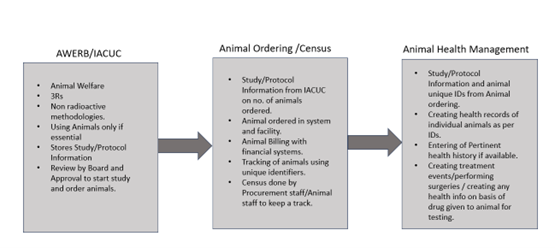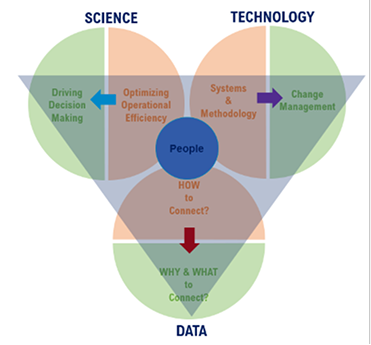Introduction:
Animals are routinely used in the pre-clinical development phase of pharmaceutical development, with the industry accounting for approximately one-third of animal research in the UK. Many current informatics systems, initially designed to support now outdated lab processes, play a crucial role in managing animal health & welfare but face numerous scientific and technological challenges. With the advent of technologies like Machine Learning (ML) and Artificial Intelligence (AI), there’s potential to reduce the reliance on in-vivo testing for regulatory approvals. This paper explores transformative changes in business processes and technologies that could reduce the need for animal studies in the development of new medicines and treatments.
Business Process:
Organizations adhere to diverse business processes in animal research operations, yet standard practices emerge across most big pharma companies. This process typically unfolds in three sequential steps:
- Ethical considerations: Focus is on using animals only when necessary and ensuring ethical treatment. The Animal Welfare and Ethical Review Body (AWERB) in the UK, akin to the Institutional Animal Care and Use Committees (IACUC) in the USA, enhances scientific and animal welfare and fosters a culture of care while improving public accountability. In the UK, The Animals (Scientific Procedures) Act 1986, enforced by the Home Office’s Science Regulation Unit, mandates project authorization and ethical review. Whilst similar committees exist worldwide, regulatory frameworks can vary. The key responsibilities of AWERBs in the UK include:
- Forum for ethical discussion: Provide a platform for discussing and developing ethical advice related to animal welfare, care and use, which helps inform decisions by the establishment license holder.
- Promotion of animal welfare: Raise awareness of animal welfare principles and the 3R’s (Reduction, Replacement and Refinement), which guide the ethical use of animals in research.
- Support for staff: Offer support to named persons and other staff members who handle animals, addressing any animal welfare and ethical concerns.
- Cultural promotion: Foster a 'Culture of Care' within research establishments, ensuring that welfare considerations are integrated into daily practices and decision-making.
- Animal procurement: Animals are ordered only after AWERB approval. Modern IT systems should seamlessly handle all related tasks—from reviewing study requirements and detailing the procedures needed to be performed on the animal by scientists or vets, to managing procurement and integrating financial processes—ensuring accuracy and efficiency throughout.
- Health management of animals: Scientists and veterinary staff are responsible for the ongoing health management of the animals, maintaining all treatment plans and recordingincidents/surgeries within the IT system.
This structured approach ensures that ethical considerations are thoroughly integrated into the management of animal research, reflecting a commitment to responsible scientific inquiry and the welfare of both animals and staff.

Image 1: This image depicts the typical animal management business process in pharmaceutical and research organizations.
Despite the efficiency of current IT systems in managing various tasks related to animal management in pharmaceutical and research industries, significant challenges persist, which will be explored in the following section.
Challenges with the Current In Vivo Testing Process and IT Systems
Several issues continue to undermine the effectiveness of existing protocols and systems:
- Independence and oversight: AWERB, while subject to Home Office audits, lacks a defined audit frequency and functions non-independently within organizations, potentially resulting in biased decisions when specific drug research is conducted. Primarily, AWERB offers recommendations on reducing, replacing, and refining the use of animals rather than halting their use in research, thus limiting its oversight capabilities and the visibility of potential biases. This issue is common to internal bodies and committees within many organizations.
- Financial Systems Integration: Many organizations lack robust financial integration with IT systems, leading to inefficiencies such as bulk ordering of animals without precise need estimates.
- Animal Health Records: Inadequate health histories for animals can result in improper treatment plans, akin to a clinician prescribing medication without knowledge of a patient’s medical history. This oversight can lead to unforeseen drug interactions or, in cases where animals are unsuitable or allergic to certain medications, severe distress or euthanasia.
- IT system reliability: Reliance on IT systems to manage treatment plans and scheduled events, such as surgeries or medication times for animals, can lead to critical delays or omissions in care if the system fails, adversely affecting the animals’ quality of life.
- Integration and accuracy: Poor integration and data management within IT systems can lead to errors, such as assigning too many animals to a study, and may result in unnecessary animal suffering and loss. In the worst IT systems, reliance on manual processes persists, further compounding the potential for errors.
- Costs for utilizing animals in studies: The cost of using animals in research is substantial, impacting not only the lives of the animals but also the financial budgets of R&D organizations. Significant resources are wasted when animal studies do not yield successful outcomes, making cost one of the most significant yet overlooked challenges in the entire business process.
These issues underscore critical concerns related to animal welfare. Beyond this, there are numerous other challenges, such as discrepancies between the actual and recorded number of animals, poorly managed animal identification, and inconsistent animal health data. Next, we will explore how AI could revolutionize the current landscape of animal research.
How AI Could Revolutionize Animal Research
Artificial Intelligence (AI) offers transformative potential for animal research, with capabilities spanning complex problem-solving across various scientific and medical disciplines. By reducing reliance on animal testing, AI could usher in methods that are not only humane but also more efficient and less costly.
Understanding AI's Role in Research
Artificial Intelligence (AI) and Machine Learning (ML) involve the development of intelligent systems that perform tasks typically requiring human intelligence. These systems are adept at learning from data to support informed decisions, a crucial feature for modeling biological responses without physical testing. Some key concepts include Machine Learning, Deep Learning, Neural Networks, Natural Language Processing (NLP) and computer vision.
Key AI Processes in Animal Research
- Data Collection: AI systems analyze extensive data from previous studies, including drug responses and genetic information, to predict outcomes without animal testing. For example, data on how mice respond to Meloxicam can forecast reactions in new tests. Data extends beyond mere observations of animal behavior; it encompasses genetic profiles, physiological measurements, and histopathological images, among others. The criticality of this data lies in its relevance and representation of the specific challenges AI systems are designed to address. In this context, the goal is to predict an animal's or species' reaction to a drug without actual exposure. This approach of predictive modeling is equally applicable to and valuable in human medical research.
- Data preprocessing: Before AI algorithms can effectively process the data, it undergoes essential preprocessing steps. This process includes cleansing the data to remove inaccuracies, eliminating noise or outliers, and normalizing or scaling the data for consistency. Additionally, the data is transformed into a format suitable for detailed analysis. For instance, in the case of Meloxicam, preprocessing is critical due to the potential presence of duplicate data from multiple pharmacokinetics and pharmacodynamics (PK/PD) studies with similar results. Such duplicity must be resolved, and the data enriched and reformatted into a standardized variable ontology or catalog as necessary.
- Algorithm selection: The choice of AI algorithms is determined by the specific task and data characteristics. Selection is strategically aligned with the problem at hand and the desired outcomes. For example, in studies involving Meloxicam, the initial goal is to predict its effect on rats without actual drug administration. A general machine learning algorithm may suffice for this. However, if the objective extends to understanding health outcomes in mice that received Meloxicam and subsequently died, a different, more specialized algorithm might be necessary to detect patterns or causative factors in their health histories that contributed to their death.
- Model training: During this stage, the chosen AI algorithm is trained using the prepared “training” data. The algorithm learns from the input data by discerning patterns, correlations, or features relevant to the research objectives. This training phase involves adjusting the algorithm's internal parameters to optimize its performance based on a defined objective or loss function. For instance, in the context of Meloxicam studies, the algorithm is tailored to detect and learn from data patterns, correlations, and features that are relevant to the disease and drug/treatment response.
- Model evaluation: Once training is complete, the performance of the AI model is assessed using separate test data that was not utilized during training. This evaluation measures how effectively the model generalizes to new, unseen data and assesses metrics such as accuracy, precision, recall, or other pertinent criteria. In our Meloxicam study, for instance, this evaluation phase will help researchers determine the model’s reliability in making predictions about animal health, disease progression, treatment efficacy, as well as drug response.
- Model deployment: Once the model is validated, researchers can leverage its capabilities to screen and evaluate potential drug candidates; for example, predicting how healthy mice might respond to Meloxicam without actual administration. Moreover, by inputting information about specific animal health history and habits, the AI model should be able to predict reactions to the drug based on the data gathered from historical animal models.
Impact of AI on Animal Testing:
The integration of AI into research protocols can dramatically decrease the need for animal subjects by identifying the most promising drug candidates early in the research process. This not only streamlines development but also enhances ethical standards by minimizing animal use. With computer vision and reliable datasets, AI models can save the lives of millions of animals. It is one of the alternatives to in-vivo testing and could show enormous promise for producing dependable and safe drug discovery outcomes. As a result, there would be significantly reduced or even no need to use animal testing.
Existing Alternatives to Animal Testing:
Minimizing animal testing in drug development is not only a humane and ethical pursuit but also shortens and reduces the costs of the drug development process. This approach alleviates the burden of extensive animal testing on researchers. Several organizations are already pioneering these alternative methods, as highlighted below:
- VeriSIM Life is building AI-enabled biosimulation models. Animal testing is slow, ethically questionable, and doesn't act as much of a filter. VeriSIM's solution is to create disease-specific biosimulation models, which allow researchers at pharma companies to model in software how a drug will interact in animals. This allows researchers to test 1000x more potential candidates in the same unit of time, ensuring that drugs that do make it to (human) clinical trials are far more likely to work, and therefore saving millions in annual costs.
- Quris AI (with operations in Israel and Boston) is advancing toward clinical trials its first fully AI-designed drug for treating fragile X syndrome, a rare autism-associated condition. The company utilizes its Bio-AI Clinical Prediction Platform, which uses simulated organs to predict drug interactions. This innovative approach has the potential to obfuscate the need for mice in pre-clinical safety trials, thereby decreasing both the time and financial costs associated with unsuccessful experiments.
- Exscientia have automated drug design and have AI-designed molecules entering clinical trials. By generating and analyzing their own data using advanced AI algorithms, Exscientia significantly shortens the pre-clinical drug discovery process, substantially accelerating the transition to clinical testing phases.
Significant opportunities remain to innovate and transform the landscape of in-vivo studies and experiments through advancements in study designs and experimental methodologies.
Conclusion
It is possible to predict the attributes of new potential drug molecules using the data we already have about past tests and experiments. In some instances, toxicity predictions for tens of thousands of unknown chemicals, based on previous studies, are now more accurate and reliable than the results from actual animal studies. Despite these advances, animal testing remains necessary for compounds with no historical data. This white paper explores how AI could revolutionize the current animal testing process, benefitting animal welfare and enhancing the efficiency, cost-effectiveness and productivity of pharmaceutical research.
References:
1. https://mixed-news.com/en/can-virtual-reality-and-ai-end-torturous-animal-testing/
2. https://www.pharmavoice.com/news/Quris-pharma-artificial-intelligence-animal-testing-mouse/622640/
3. https://www.livekindly.com/artificial-intelligence-end-animal-testing/
For questions or clarifications: info@zifornd.com



